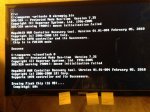MMacD
Explorer
- Joined
- Dec 12, 2014
- Messages
- 55
Although I get a "base address too high - not supported" warning, my
megarec -writesbr 0 sbrempty.bin
claimed to have worked.
But the
megarec -cleanflash 0
failed, error 64. I can't find any documentation on the megarec utility, so I don't know what error 64 is. I suppose it might be "file not found", since it seems to have been expecting a filename after the zero, but since no filename is given on the howto examples, I don't know what to make of that.
SO my questions are
- is the "base address" warning serious, or is it just complaining because I'm trying to talk to it via DOS? If serious, is it fixable? If fixable, could someone point me at the howto?
- how do I get past the -cleanflash error? The utility only suggests that I try again, which I did. Repeatedly, but to no avail.
I'm trying to do the xflash on a dev machine, not the one I'll use for the NAS (the mamaboard for which I've not purchased yet. It will probably be an A1SRM-2558F.).
This system has a GA970A-UD3P, with a UEFI BIOS. I made a bootable FreeDOS thumb using Rufus 2.4. It booted fine, saw the card, and everything seemed to go well until the -cleanflash failed.
Thanks in advance for any clues, pointers, et similar.
megarec -writesbr 0 sbrempty.bin
claimed to have worked.
But the
megarec -cleanflash 0
failed, error 64. I can't find any documentation on the megarec utility, so I don't know what error 64 is. I suppose it might be "file not found", since it seems to have been expecting a filename after the zero, but since no filename is given on the howto examples, I don't know what to make of that.
SO my questions are
- is the "base address" warning serious, or is it just complaining because I'm trying to talk to it via DOS? If serious, is it fixable? If fixable, could someone point me at the howto?
- how do I get past the -cleanflash error? The utility only suggests that I try again, which I did. Repeatedly, but to no avail.
I'm trying to do the xflash on a dev machine, not the one I'll use for the NAS (the mamaboard for which I've not purchased yet. It will probably be an A1SRM-2558F.).
This system has a GA970A-UD3P, with a UEFI BIOS. I made a bootable FreeDOS thumb using Rufus 2.4. It booted fine, saw the card, and everything seemed to go well until the -cleanflash failed.
Thanks in advance for any clues, pointers, et similar.

